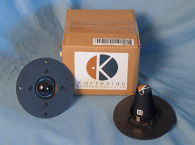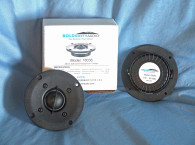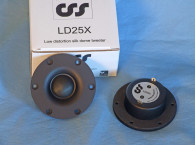







Trueanalog sent Voice Coil its new 28 mm diameter silk dome tweeter, the TAFE28, intended for high end hi-fi and recording studio applications (see Photo 1). Features include a coated silk/cotton-type diaphragm and surround made from a string weave using twisted cotton and silk, super low carbon content steel for the front plate and T-yoke (the low carbon steel from Sumitomo is coupled with a proprietary forging process), a two-layer 28 mm diameter CCAW voice coil wound on an aluminum former, a felt damped pole piece venting into a shaped and damped plastic back enclosure (see Photo 2). This tweeter does not use magnetic fluid in the gap area, which I prefer on higher-end system designs. It has 92 dB sensitivity and a nominal 6 Ω impedance. Looking at Photo 1, you can see that the TAFE28 uses three 2 mm diameter bolts to center the diaphragm assembly for mounting.
To begin, I used the LinearX LMS analyzer to produce the 300-point impedance sweep illustrated in Figure 1. The primary tweeter resonance occurs at a moderately low 757 Hz. With a 5.73 Ω DCR (Re), the minimum impedance for this tweeter is 6.24 Ω at 4.23 kHz.
Following the impedance test, I recess mounted the TAFE28 in an enclosure with a baffle area of 17” × 8” and measured the on- and off-axis frequency response. I set up the Loudsoft FINE R+D analyzer and GRAS 46BE 1/4” microphone to measure the 200 Hz to 40 kHz frequency response (using a 192 kHz sampling rate) at 2 V/0.5 m normalized to 2.83 V/1 m. Sweeps were performed at 0°, 15°, 30°, and 45°.
Figure 2 shows the TAFE28’s on-axis response, which measured ±2.5 dB from 1.2 kHz to 11 kHz, followed by a 4 dB rise between 11 kHz to 20 kHz. Figure 3 gives the on- and off-axis response. Figure 4 shows the off-axis curves normalized to the on-axis response. Figure 5 shows the CLIO 180° polar plot (measured in 10° increments with 1/3 octave smoothing). Figure 6 shows the TAFE28’s two-sample SPL comparison, indicating the two samples were closely matched to within 0.5 dB to 1 dB throughout its operating range from 2 kHz to 20 kHz.



For the final group of tests I once more fired up the Listen, Inc. SoundCheck AudioConnect analyzer along with the Listen SCM 2 1/4” microphone and measured the impulse response with the tweeter recess-mounted on the same 17” × 8” test baffle. Importing this data into the Listen SoundMap software produced the CSD waterfall plot shown in Figure 7. Figure 8 displays the STFT surface plot. For the final test procedure, I used a noise stimulus to set the 1 m SPL to 94 dB (5.6 V) and measured the second and third harmonic distortion at 10 cm (see Figure 9).
As can be seen, the distortion is dominated by the second harmonic with very low third-harmonic distortion. The build quality of the Trueanalog TAFE28 is definitely appropriate to the mid to high-end two-channel and studio monitor market. So, given the data collected for the TAFE28, I would say it’s a very nice first offering from Trueanalog.
For more information, visit www.trueanalog.com. VC
This article was originally published in Voice Coil, October 2019.







